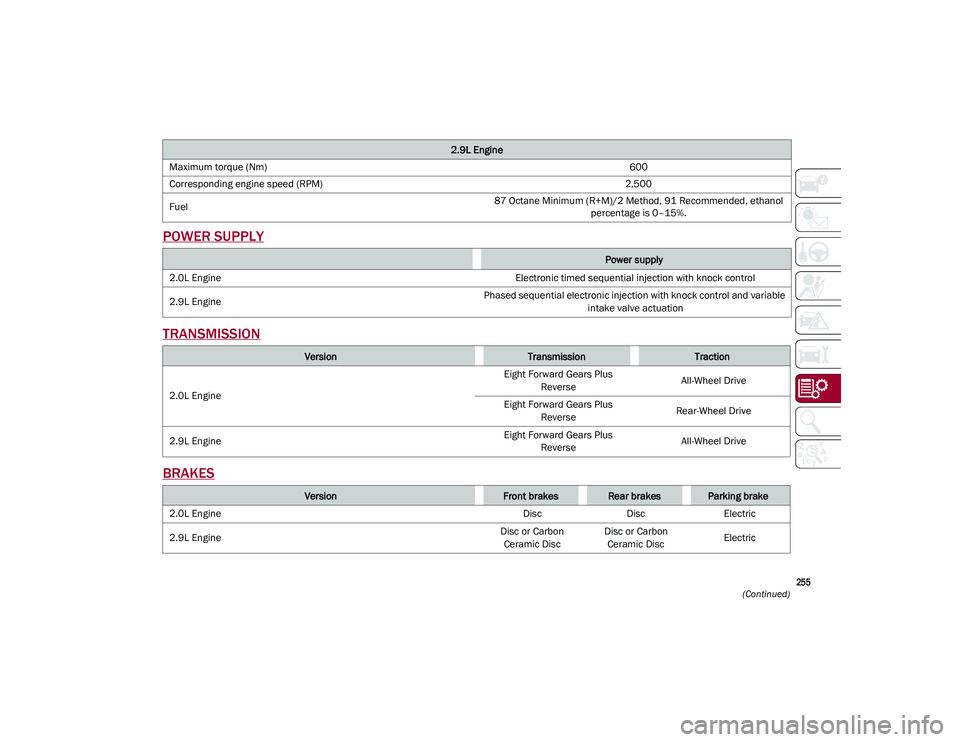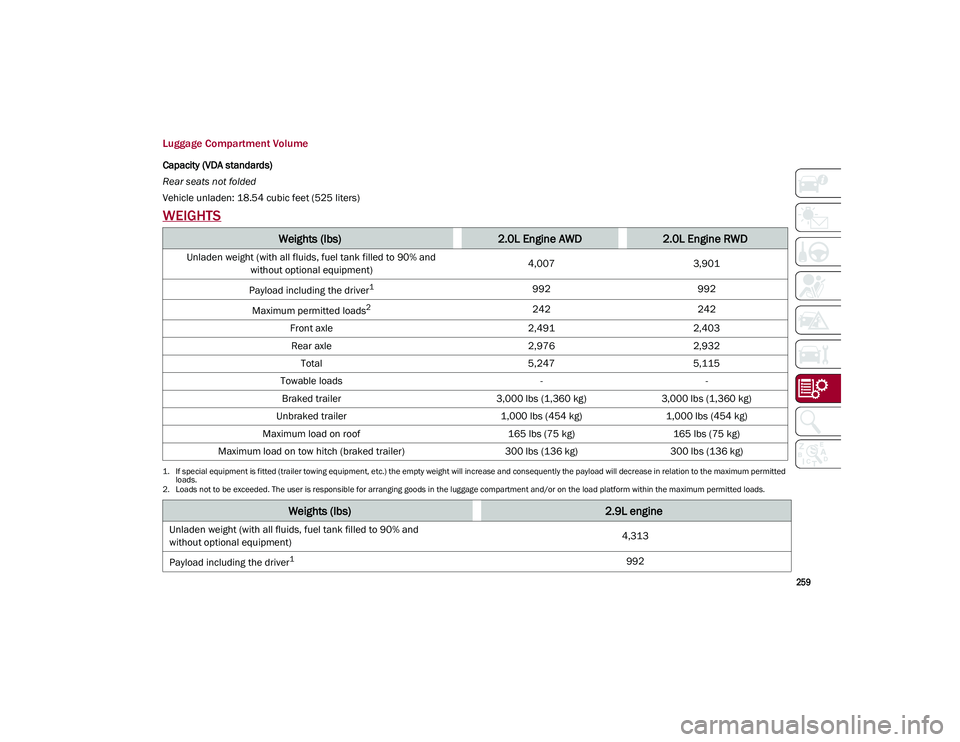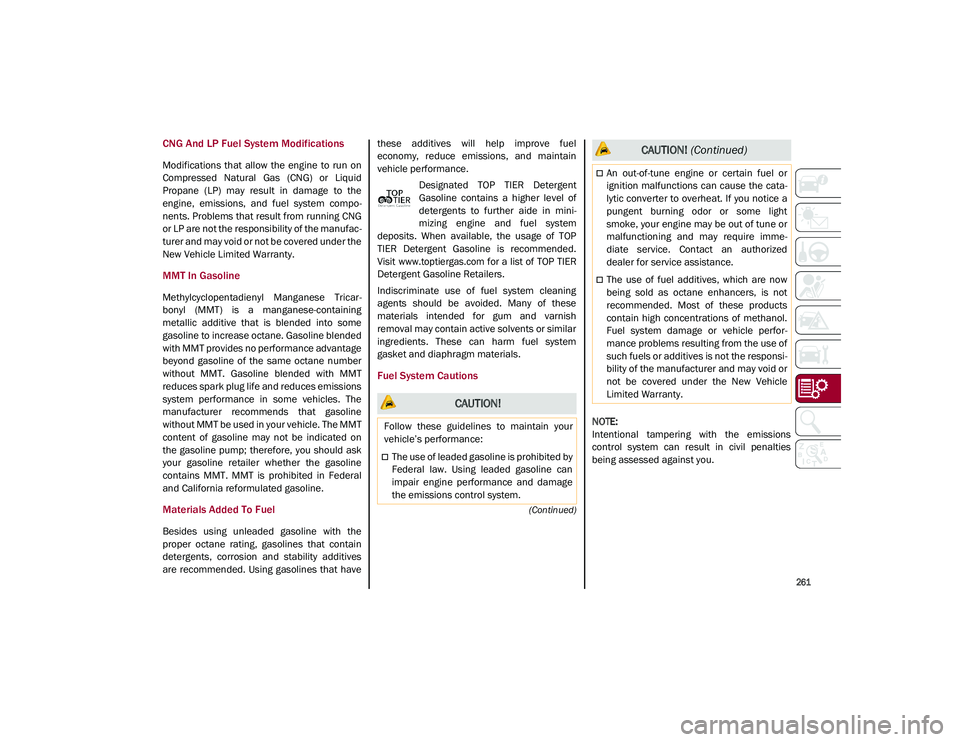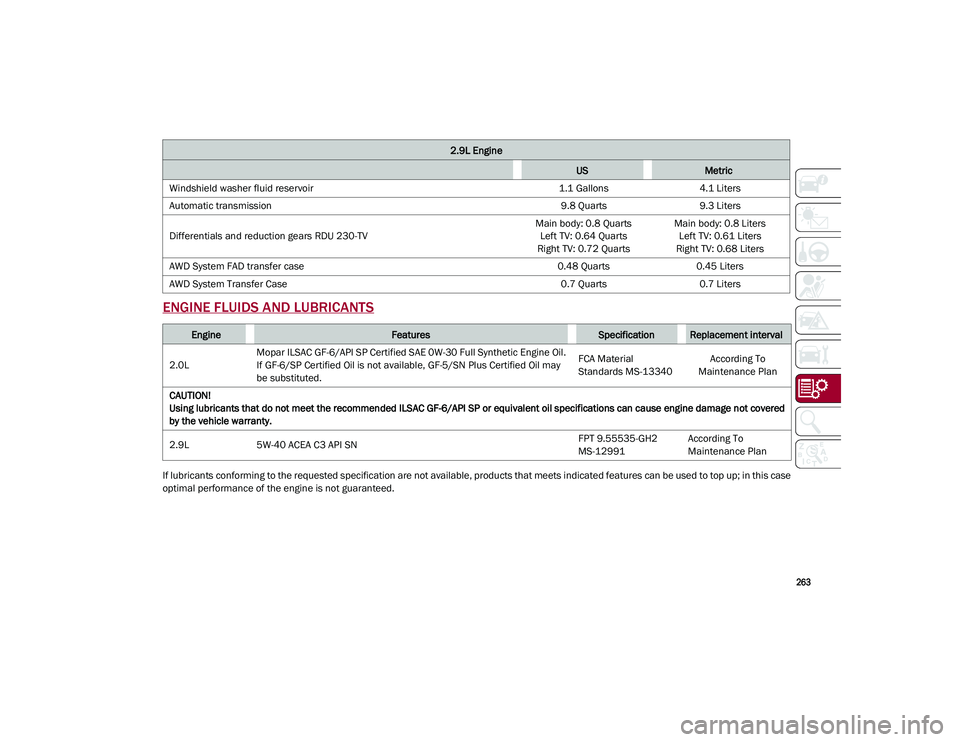2021 ALFA ROMEO STELVIO engine
[x] Cancel search: enginePage 257 of 280

255
(Continued)
POWER SUPPLY
TRANSMISSION
BRAKES
Maximum torque (Nm) 600
Corresponding engine speed (RPM) 2,500
Fuel 87 Octane Minimum (R+M)/2 Method, 91 Recommended, ethanol
percentage is 0–15%.
Power supply
2.0L Engine Electronic timed sequential injection with knock control
2.9L Engine Phased sequential electronic injection with knock control and variable
intake valve actuation
VersionTransmissionTraction
2.0L Engine Eight Forward Gears Plus
Reverse All-Wheel Drive
Eight Forward Gears Plus Reverse Rear-Wheel Drive
2.9L Engine Eight Forward Gears Plus
Reverse All-Wheel Drive
VersionFront brakesRear brakesParking brake
2.0L Engine DiscDiscElectric
2.9L Engine Disc or Carbon
Ceramic Disc Disc or Carbon
Ceramic Disc Electric
2.9L Engine
21_GU_OM_EN_USC_t.book Page 255
Page 258 of 280

TECHNICAL SPECIFICATIONS
256
SUSPENSION
STEERING
CAUTION!
Water, ice and salt spread on the roads may deposit on the brake discs, reducing braking efficiency the first time the brakes are applied.
To obtain the maximum efficiency of the braking system, a bedding-in period of about 300 miles (500 km) is needed: during this period it is
better to avoid sharp, repeated and prolonged braking.
VersionFrontRear
2.0L Engine Independent wheel
double-wishbone suspension Independent wheel with
multilink system
2.9L Engine Independent wheel
double-wishbone suspension Independent wheel with
multilink system
VersionCurb-to-curb turning circleType
2.0L Engine 38.55 ft (11.75 m)Rack and pinion with electric
power steering
2.9L Engine 37.10 ft (11.30 m)Rack and pinion with electric
power steering
21_GU_OM_EN_USC_t.book Page 256
Page 261 of 280

259
Luggage Compartment Volume
Capacity (VDA standards)
Rear seats not folded
Vehicle unladen: 18.54 cubic feet (525 liters)
WEIGHTS
Weights (lbs)2.0L Engine AWD2.0L Engine RWD
Unladen weight (with all fluids, fuel tank filled to 90% and without optional equipment) 4,007
3,901
Payload including the driver
1
1. If special equipment is fitted (trailer towing equipment, etc.) the empty weight will increase and consequently the payload will decrease in relation to the maximum permitted loads.
992 992
Maximum permitted loads
2
2. Loads not to be exceeded. The user is responsible for arranging goods in the luggage compartment and/or on the load platform within the maximum permitted loads.
242 242
Front axle 2,4912,403
Rear axle 2,9762,932
Total 5,2475,115
Towable loads --
Braked trailer 3,000 lbs (1,360 kg)3,000 lbs (1,360 kg)
Unbraked trailer 1,000 lbs (454 kg)1,000 lbs (454 kg)
Maximum load on roof 165 lbs (75 kg)165 lbs (75 kg)
Maximum load on tow hitch (braked trailer) 300 lbs (136 kg)300 lbs (136 kg)
Weights (lbs)2.9L engine
Unladen weight (with all fluids, fuel tank filled to 90% and
without optional equipment) 4,313
Payload including the driver
1992
21_GU_OM_EN_USC_t.book Page 259
Page 262 of 280

TECHNICAL SPECIFICATIONS
260
FUEL REQUIREMENTS
This engine is designed to meet all
emission regulations, and provide
satisfactory fuel economy and
performance when using
high-quality unleaded “Regular” gasoline
having a posted octane number of 87 as spec -
ified by the (R+M)/2 method. For optimal
performance the use of 91 or higher octane
“Premium” gasoline is recommended in these
engines.
While operating on gasoline with the required
octane number, hearing a light knocking
sound from the engine is not a cause for
concern. However, if the engine is heard
making a heavy knocking sound, see an
authorized dealer immediately. Use of gaso -
line with a lower than recommended octane
number can cause engine failure and may void
or not be covered by the New Vehicle Limited
Warranty. Poor quality gasoline can cause problems
such as hard starting, stalling, and hesitations.
If you experience these symptoms, try another
brand of gasoline before considering service
for the vehicle.
Reformulated Gasoline
Many areas of the country require the use of
cleaner burning gasoline referred to as “refor
-
mulated gasoline”. Reformulated gasoline
contains oxygenates and are specifically
blended to reduce vehicle emissions and
improve air quality.
The use of reformulated gasoline is recom -
mended. Properly blended reformulated gaso -
line will provide improved performance and
durability of engine and fuel system compo -
nents.
Gasoline/Oxygenate Blends
Some fuel suppliers blend unleaded gasoline
with oxygenates such as ethanol. Problems that result from using gasoline
containing more than 15% ethanol (E-15) or
gasoline containing methanol are not the
responsibility of the manufacturer and may
void or not be covered under New Vehicle
Limited Warranty.
Maximum permitted loads
2242
– Front axle 2,579
– Rear axle 2,976
– Total 5,423
Maximum load on roof 165 lbs (75 kg)
1. If special equipment is fitted the empty weight will increase and consequently the payload will decrease in relation to the maximum permitted loads.
2. Loads not to be exceeded. The user is responsible for arranging goods in the luggage compartment and/or on the load platform within the maximum permitted loads.
Weights (lbs)2.9L engine
CAUTION!
DO NOT use E-85, gasoline containing
methanol, or gasoline containing more than
15% ethanol (E-15). Use of these blends
may result in starting and drivability
problems, damage critical fuel system
components, cause emissions to exceed
the applicable standard, and/or cause the
Malfunction Indicator Light to illuminate.
Please observe pump labels as they should
clearly communicate if a fuel contains
greater than 15% ethanol (E-15).
21_GU_OM_EN_USC_t.book Page 260
Page 263 of 280

261
(Continued)
CNG And LP Fuel System Modifications
Modifications that allow the engine to run on
Compressed Natural Gas (CNG) or Liquid
Propane (LP) may result in damage to the
engine, emissions, and fuel system compo-
nents. Problems that result from running CNG
or LP are not the responsibility of the manufac -
turer and may void or not be covered under the
New Vehicle Limited Warranty.
MMT In Gasoline
Methylcyclopentadienyl Manganese Tricar -
bonyl (MMT) is a manganese-containing
metallic additive that is blended into some
gasoline to increase octane. Gasoline blended
with MMT provides no performance advantage
beyond gasoline of the same octane number
without MMT. Gasoline blended with MMT
reduces spark plug life and reduces emissions
system performance in some vehicles. The
manufacturer recommends that gasoline
without MMT be used in your vehicle. The MMT
content of gasoline may not be indicated on
the gasoline pump; therefore, you should ask
your gasoline retailer whether the gasoline
contains MMT. MMT is prohibited in Federal
and California reformulated gasoline.
Materials Added To Fuel
Besides using unleaded gasoline with the
proper octane rating, gasolines that contain
detergents, corrosion and stability additives
are recommended. Using gasolines that have these additives will help improve fuel
economy, reduce emissions, and maintain
vehicle performance.
Designated TOP TIER Detergent
Gasoline contains a higher level of
detergents to further aide in mini -
mizing engine and fuel system
deposits. When available, the usage of TOP
TIER Detergent Gasoline is recommended.
Visit
www.toptiergas.com
for a list of TOP TIER
Detergent Gasoline Retailers.
Indiscriminate use of fuel system cleaning
agents should be avoided. Many of these
materials intended for gum and varnish
removal may contain active solvents or similar
ingredients. These can harm fuel system
gasket and diaphragm materials.
Fuel System Cautions
NOTE:
Intentional tampering with the emissions
control system can result in civil penalties
being assessed against you.
CAUTION!
Follow these guidelines to maintain your
vehicle’s performance:
The use of leaded gasoline is prohibited by
Federal law. Using leaded gasoline can
impair engine performance and damage
the emissions control system.
An out-of-tune engine or certain fuel or
ignition malfunctions can cause the cata -
lytic converter to overheat. If you notice a
pungent burning odor or some light
smoke, your engine may be out of tune or
malfunctioning and may require imme -
diate service. Contact an authorized
dealer for service assistance.
The use of fuel additives, which are now
being sold as octane enhancers, is not
recommended. Most of these products
contain high concentrations of methanol.
Fuel system damage or vehicle perfor -
mance problems resulting from the use of
such fuels or additives is not the responsi -
bility of the manufacturer and may void or
not be covered under the New Vehicle
Limited Warranty.
CAUTION! (Continued)
21_GU_OM_EN_USC_t.book Page 261
Page 264 of 280

TECHNICAL SPECIFICATIONS
262
FLUID CAPACITIES
2.0L Engine
USMetric
Fuel tank 16.9 Gallons64 Liters
Fuel tank reserve 2.5 Gallons9.6 Liters
Engine cooling system 2.3 Gallons8.8 Liters
Intercooler cooling system 1.4 Gallons5.25 Liters
Engine oil sump and filter 5.5 Quarts5.2 Liters
Hydraulic brake circuit 0.9 Quarts0.9 Liters
Windshield washer fluid reservoir 1.1 Gallons4.1 Liters
Automatic transmission 9.8 Quarts9.3 Liters
RDU 230-LSD differential 0.9 Quarts0.9 Liters
RDU 210-eLSD differential (if equipped) 1.4 Quarts1.3 Liters
RDU 210/215-LSD differential 1.1 Quarts1.1 Liters
AWD System FAD transfer case 0.5 Quarts0.5 Liters
AWD System Transfer Case 0.7 Quarts0.7 Liters
2.9L Engine
USMetric
Fuel tank 16.9 Gallons64 Liters
Fuel tank reserve 2.5 Gallons9.6 Liters
Engine cooling system 2.95 Gallons11.2 Liters
Intercooler cooling system 1.5 Gallons5.75 Liters
Engine oil sump and filter 7.2 Quarts7 Liters
Hydraulic brake circuit 0.9 Quarts0.9 Liters
21_GU_OM_EN_USC_t.book Page 262
Page 265 of 280

263
ENGINE FLUIDS AND LUBRICANTS
If lubricants conforming to the requested specification are not available, products that meets indicated features can be used to top up; in this case
optimal performance of the engine is not guaranteed.Windshield washer fluid reservoir
1.1 Gallons4.1 Liters
Automatic transmission 9.8 Quarts9.3 Liters
Differentials and reduction gears RDU 230-TV Main body: 0.8 Quarts
Left TV: 0.64 Quarts
Right TV: 0.72 Quarts Main body: 0.8 Liters
Left TV: 0.61 Liters
Right TV: 0.68 Liters
AWD System FAD transfer case 0.48 Quarts0.45 Liters
AWD System Transfer Case 0.7 Quarts0.7 Liters
EngineFeaturesSpecificationReplacement interval
2.0L Mopar ILSAC GF-6/API SP Certified SAE 0W-30 Full Synthetic Engine Oil.
If GF-6/SP Certified Oil is not available, GF-5/SN Plus Certified Oil may
be substituted. FCA Material
Standards MS-13340 According To
Maintenance Plan
CAUTION!
Using lubricants that do not meet the recommended ILSAC GF-6/API SP or equivalent oil specifications can cause engine damage not covered
by the vehicle warranty.
2.9L 5W-40 ACEA C3 API SN FPT 9.55535-GH2
MS-12991 According To
Maintenance Plan
2.9L Engine
USMetric
21_GU_OM_EN_USC_t.book Page 263
Page 266 of 280

TECHNICAL SPECIFICATIONS
264
CHASSIS FLUIDS AND LUBRICANTS
UseFeaturesSpecificationApplications
Lubricants and greases ZF 8HP 50 – Synthetic ATF –
Automatic transmission-2.0L / 2.9L
SAE 75W-85 Synthetic ATF FPW9.55550–DA9 Differential
RDU 195; RDU 230-LSD; RDU 210-eLSD;
RDU 210/215-LSD / 2.0L engine
SAE 75W-80 APL GL-5
Synthetic lubricant FPW9.55550–DA10AWD System FAD transfer case / 2.0L
Differential and reduction units RDU
230-TV / 2.9L
SAE 75W Synthetic lubricant FPW9.55550–DA11 AWD System transfer case
Brake fluid DOT 4MS.90039Hydraulic brakes
Engine coolant CUNA NC956–16
ASTMD3306MS.90032Mix a minimum solution of 50% engine
coolant. Not mixable with different
formulation products.
1 1.
For particularly harsh climate conditions, a mixture of 60 % pro d
uct and 40% distilled water is recommended.
Windshield washer fluid CUNA NC 956-11 MS.90043To be used diluted or undiluted in
windshield washer/wiper systems.
HVAC R1234yf or R134a (depending
on the market) –
–
CAUTION!
The use of products with different specifications than those indicated above could cause damage to the engine that is not covered by the
warranty.
21_GU_OM_EN_USC_t.book Page 264